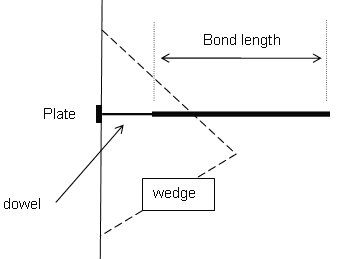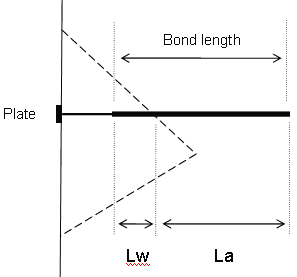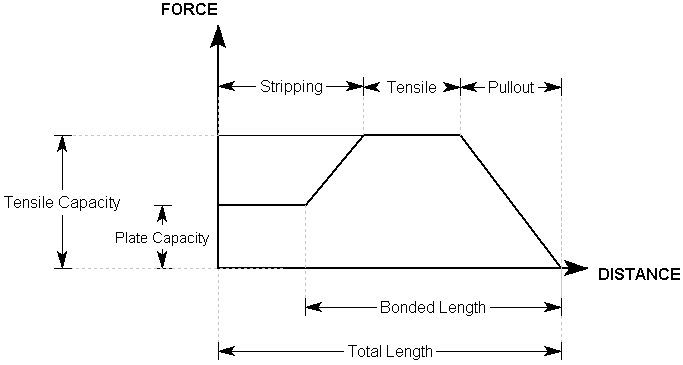Grouted Dowel
The Grouted Dowel bolt type can be used to model support which has a variable bonded (grouted) length.

General
Force Application and Orientation
- Force Application: Active or Passive
- Use Bolt Orientation Efficiency (optional): Cosine Tension/Shear or Linear Tension/Shear
- The tensile capacity determined from the Bolt Force Diagram assumes that a bolt is mobilized in pure tension. However, this will usually not be the case, and a bolt which intersects a block may also be in shear or even compression. A Bolt Orientation Efficiency factor (0 to 1) can be applied to the tensile capacity of the bolt determined from the Bolt Force Diagram. The efficiency factor accounts for the fact a bolt will in general not be mobilized in pure tension but may include shear or compression. See the Bolt Orientation Efficiency topic for more information.
- The tensile capacity determined from the Bolt Force Diagram assumes that a bolt is mobilized in pure tension. However, this will usually not be the case, and a bolt which intersects a block may also be in shear or even compression. A Bolt Orientation Efficiency factor (0 to 1) can be applied to the tensile capacity of the bolt determined from the Bolt Force Diagram. The efficiency factor accounts for the fact a bolt will in general not be mobilized in pure tension but may include shear or compression. See the Bolt Orientation Efficiency topic for more information.
Tensile
- Tensile Capacity represents the maximum tensile capacity of the bolt itself (i.e., steel tensile capacity), independent of the plate capacity or the bond capacity. Units are Force.
Shear and Compression
- Use Shear Capacity (optional): Shear Capacity
- Use Compression Capacity (optional): Compression Capacity
Pullout and Stripping
Plate Capacity
- Plate Capacity represents the maximum load which can be sustained by the plate assembly which connects the dowel to the exposed block face. Units are Force.
Bond Strength
- Bond Strength expressed as a Force per unit Length, where the length refers to the length along the dowel. The maximum pullout force is therefore simply the Bond Length of the dowel, multiplied by the Bond Strength.
- Material Dependent (optional): sum of bond strength of material x bolt length passing through material specified, otherwise the global Bond Strength is used
- Use Percent of Length can be either
- Length of actual bond length, starting from the end of the bolt
- Percent of total bolt length, starting from the end of the bolt
Bolt Force Diagram
The Grouted Dowel tensile properties which are entered in the Define Bolt Properties dialog, are used to determine a Force Diagram for the dowel, as described below.
Consider a dowel which intersects a block as follows:

Where:
Lw = wedge length = bonded length of dowel within wedge
La = anchorage length = bonded length of dowel embedded in rock beyond wedge
Dowel Parameters:
T = Tensile Capacity (force)
P = Plate Capacity (force)
B = Bond Strength (force / unit length of bond)
For a Grouted Dowel, at any point along the length of the dowel, there are 3 possible failure modes which are considered:
- Pullout (force required to pull the anchorage length La of the bolt out of the rock)
- Tensile Failure (maximum axial capacity of the bolt)
- Stripping (wedge failure occurs, and bolt remains embedded in rock)
The maximum force which can be mobilized by each failure mode, at any point along the bolt length, is given by the following equations:
Pullout: F1 = B * La (Eqn.1)
Tensile: F2 = T (Eqn.2)
Stripping: F3 = P + B * Lw (Eqn.3)
In order for stripping to occur, the Plate Capacity must be exceeded. The Plate Capacity is included in the stripping force equation and added to the bond capacity along the block length Lw.
At any point along the length of the bolt, the force which is applied to the block by the bolt is given by the MINIMUM of these three forces.
Applied Force = min (F1, F2, F3) (Eqn.4)
A Force diagram for a Grouted Dowel, which exhibits all three failure modes, is shown below. In this case, the Plate Capacity is less than the Tensile Capacity, and therefore "stripping" is a possible failure mode. If the Plate Capacity is greater than the Tensile Capacity, then stripping cannot occur, and the Force diagram will be determined only by the Tensile and Pullout failure modes.
